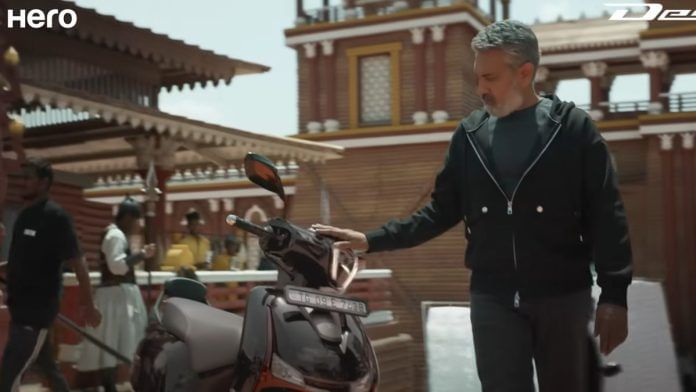Hero MotoCorp’s campaign Hero ka Scooter, Scooter ka Hero, starring filmmaker SS Rajamouli, is not an average two-wheeler commercial. The brand, along with the star power, brings grandeur and storytelling to launch a humble two-wheeler — its new Hero Destini 125. This premium scooter is introduced with the drama straight from the sets of Baahubali.
Directed by Arun Gopalan, the TVC celebrates the qualities of a true hero in the scooter segment, highlighting the product’s reliability and strength. From gliding through stairs to surviving bumpy roads and difficult terrains, the scooter does it all.
Hero MotoCorp claims that the innovations made for Destini 125 — including Retro Chrome Styling, a large floorboard for added convenience, bigger alloy wheels for stability, and an LED projector headlight with DRL — blend style, comfort, mileage, and convenience, making the model a the true Hero in its category.
But, the commercial goes beyond just highlighting the features. Scooters in India are often marketed through practicality tropes, but Hero MotoCorp chose to narrate its pitch with not just demonstration but also dramatisation.
But, PR and communications professional Dilip Cherian, widely regarded as India’s ‘Image Guru’, isn’t quite impressed with the commercial.
While Cherian admits that the commercial is an attempt to bring grandeurness to the marketing of scooters, he says it isn’t an ideal template.
“In my sense, the ad is overtop and an attempt to get attention,” he said.
“The idea is clearly to get a big star and use an existing set. The storytelling that ‘product is hero’ instead of the superstar is predictable.”
Rajamouli, known for his grand cinematic narratives, brings his larger-than-life style to the one-minute-long commercial. He is seen directing the video on a set, which mimics that of Baahubali.
Now, Baahubali’s return to theatres in the form of a combined film, Baahubali: The Epic, has already generated chatter on social media.
And, the commercial, clocking over 62 million views on YouTube within a month of its release, indicates that the brand did leverage a portion of the hype.
“Super Ad, Super Action like Rajamouli style, Super Scale and Super Hero, Great to be part of this Legendary Ad,” read a comment on the video.
Some even called it the “greatest ad ever.”
However, some felt that “Rajamouli using Destini to buy Vegetables and fruits from the market..should have used that theme..No one is going to fight a war with a 125cc scooter…”
According to Cherian, Rajamouli was roped in for the campaign because Hero is wanting to capture the south market, where Bajaj and TVS already have a strong hold. And, making their stars the face of the brand is one way to appeal to them.
“The southern audience is driven by heroes, hence, the collaboration is a smart move,” he added.
The ‘Hamara Bajaj’ movement
Marketing of scooters has evolved over the decades in India. Since the 1980s, they have been positioned as workhorses — family-friendly and efficient. In the iconic Bajaj Chetak ads, the scooter wasn’t just a vehicle — it was ‘Hamara Bajaj’, which carried dreams, families, and even social progress.
The 1989 Hamara Bajaj campaign changed the game for Indian advertising. At a time when competition was busy flaunting engineering and mileage, Bajaj took a leap of faith with an unconventional idea, celebrating something no one linked with scooters: Indianness.
The 30-second spot stitched together everyday Indians with their Bajaj scooters — a jogger, families bargaining in the market, friends cheering at a celebration. No talk of engines, numbers, or speed.
“Bajaj’s message worked because India went from an economy of shortage to plenty. The brand recognised that the market was going to get very large, therefore they simultaneously increased their production. It rode the wave of liberalisation,” said Cherian, who served as an advisor to Bajaj a decade later.
“I think at that time the fact that there was a product you could be proud of gave a sense of ownership.”
It was a risky pivot. The campaign could have fallen flat for ignoring the product’s features. Instead, it struck a chord across the nation and became a cultural landmark, setting a new standard for how brands could speak to India.
Also read: Airtel, boAt, D’YAVOL—Bads of Bollywood is a B-school in marketing & promotion
The broader truth
Later campaigns shifted the tone, with brands like Honda and TVS pushing their scooters as a youthful, stylish, and convenient ride, particularly appealing to women and first-time riders. The advertising focus moved from family utility to individuality and lifestyle, with urban backdrops.
“Pride in Indian brands doesn’t exist, especially in the vehicle segment. There isn’t a shortage mentality. The appeal to nationalism has a limited appeal,” explained Cherian. “Marketers have no option but to play around key features.”
Now, Hero MotoCorp is maybe trying to write another chapter in the marketing of scooters. And, their recent commercial starring Rajamouli is a prime example of this shift. Along with features, now grandeur and style have entered the conversation.
This approach reflects a broader truth in Indian advertising today: consumers don’t just want to be told about horsepower or efficiency.
They want a story. They want drama. They want something different that catches their attention.
That said, according to Cherain, where Hero fell short is its branding.
“People will remember the scooter and Rajamouli, but not the brand itself,” he said.
Views are personal.
(Edited by Aamaan Alam Khan)






